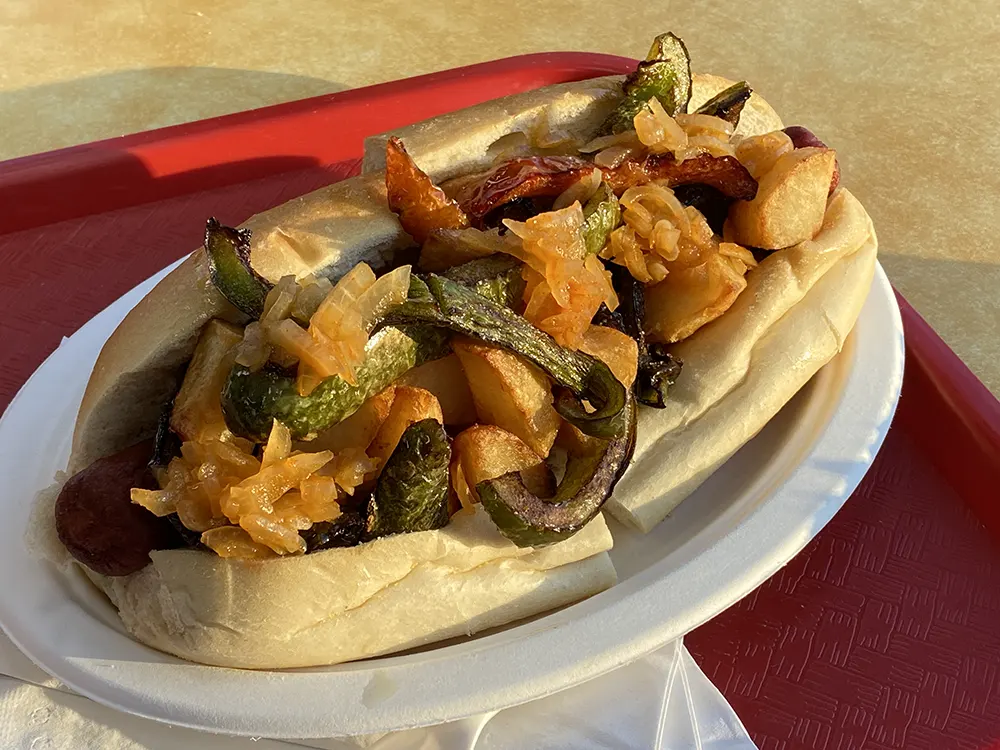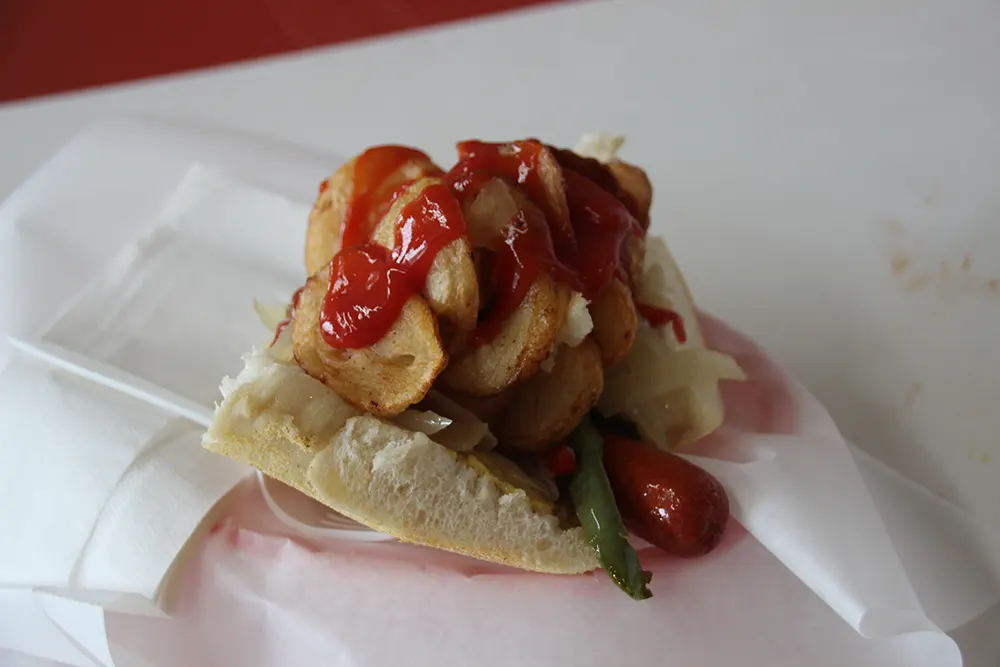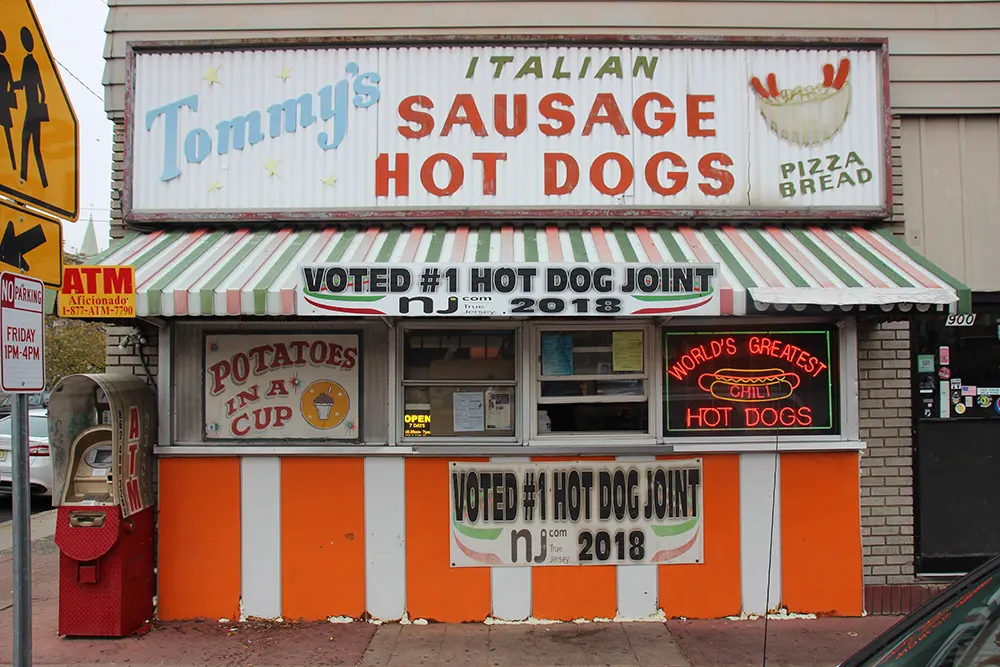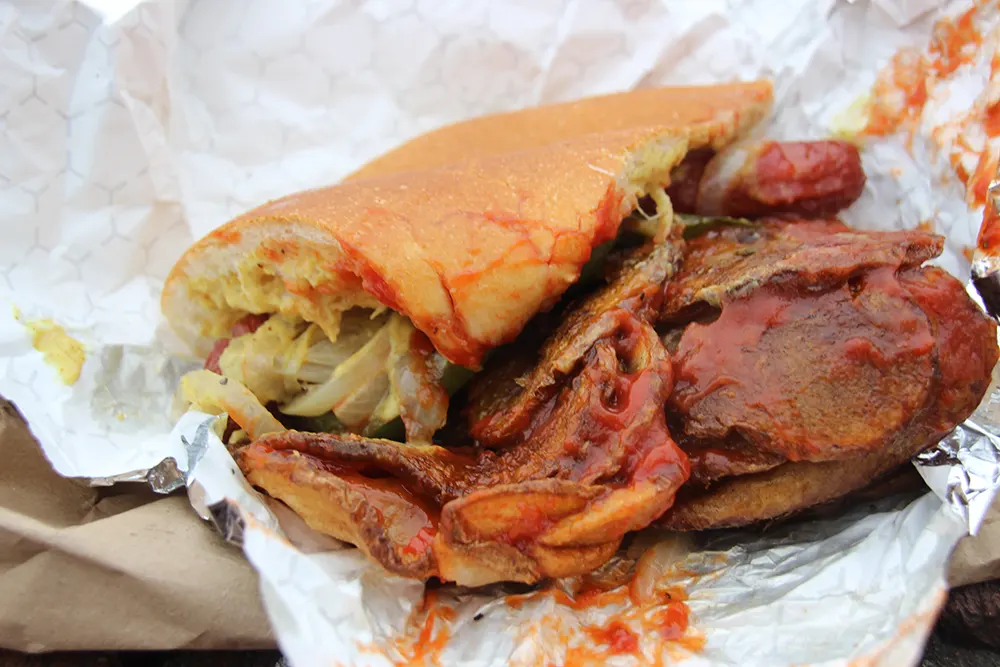The History of New Jersey’s Italian Hot Dog
By Ian MacAllen on Monday, February 19th, 2024 at 1:47 pm | 4,557 views

Italian Americans are well known for a variety of sausages, but hot dogs aren’t usually considered an Italian sausage. However, that didn’t stop the Italians in New Jersey from adopting the hot dog, and making it uniquely their own.
The New Jersey original Italian hot dog has clear links to another favorite–the sausage and pepper hero sandwich. That sandwich has been a mainstay of street festivals celebrating Italian holidays and saints since the early 20th century and were notably part of festivals like New York City’s San Gennaro feast since the late 1920s. The Italian hot dog was created a few years later.
An Italian hot dog begins with a special roll, known as “pizza” bread, a specialty available in bakeries in Newark’s Italian neighborhood. A traditional hot dog bun simply wouldn’t hold up. Pizza breads are round in shape, and soft. These are sliced in half an pulled apart to create a pocket for the sandwich fillings. The broads are then filled with two hot dogs, grilled green peppers, onions, and fried potatoes. The potatoes are typically small wedges deep fried until crispy, but also can be sliced into medallions and fried on the griddle. Even “singles,” Italian hot dogs with just one sausage, are a filling meal.

Perhaps it’s no surprise this calorie-laden creation came about in the 1930s when Americans were in the grips of the Great Depression. Tubesteaks, wieners, frankfurters, red hots–the humble hot dog– came into existence around the turn of the 20th century. There are numerous myths behind the origins with inspirations drawn from the nation’s many immigrant groups.
In the Chicago area, all-pork or pork-and-beef hot dogs were common, drawing inspiration from Polish immigrants who generally ate pork sausage. In New York and New Jersey, all-beef dogs proved more popular. One reason is that the all-beef dogs could be kosher, satisfying dietary requirements of the many Jewish immigrants in the region. Kosher meat generally was popular in the New York City area, not just because of Jewish dietary requirements, but because consumers were convinced it was free of impurities. Concerns over meat quality was particularly important in the early 20th century, especially after Upton Sinclair wrote The Jungle, a novel exposing the many impurities like human body parts, that ended up in processed meaa.
New Jersey, too, embraced the all-beef hot dogs. One major manufacturer known for their “Natural Casing Beef Frankfurters,” Sabrett, even moved to New Jersey after launching operations in the Lower East Side of Manhattan. By the 1940s, about two decades after it was founded, the company moved to Jersey City, New Jersey, and is now headquartered in Englewood. So unsurprisingly, the Italian hot dog is made with an all-beef frankfurter.
New Jersey is also home to Best Provisions, a Newark-based manufacturer of hot dogs and other processed beef products like beef bologna, salami, and bacon. The company began in Newark in 1938, and eventually became the de facto hot dog in the Italian hot dog sandwich.
Hot dogs had grown popular in American cuisine by the 1920s. Texas Weiners, topped with chili and onion was another favorite, and perhaps better known style of hot dog in New Jersey and Pennsylvania at the time. Sold in lunch rooms, carts, and small stands, hot dogs were a cheap, but filling food. But in the Italian section of Newark, New Jersey, one man was about to change the course of hot dog history.
James Racioppi was something of a gambler. He enjoyed playing cards but would often bluff his way through the games. He and his wife hosted a weekly game in their home, and his wife Mary served sandwiches.
Mary made sandwiches using the “pizza” bread sold in their neighborhood bakeries, which is why when she started serving hot dogs, she filled these round breads. The hot dogs were likely fried – a common way of cooking the franks in New Jersey – along with onions, peppers, potatoes, and mustard. Eventually, people were coming just for food rather than to play cards.
In 1932, the Racioppis opened their stand at 202 14th Ave. & 9th St. in Newark, in the University Heights area of the city. According to Roadfood, 10th Edition: An Eater’s Guide to More Than 1,000 of the Best Local Hot Spots and Hidden Gems Across America, the Racioppis realized they could sell sandwiches instead of just gambling because people kept showing up without paying cards.
The couple named their shop Jimmy Buff’s. The name came from James’s gambling. Since Jimmy was a bluffer, the name of their food stand became Jimmy Buffs–as in Jimmy, the guy who bluffs his way through card games, but with a heavy accent.

Jimmy Buffs is no longer in Newark, but there are other locations that have since opened across suburban north Jersey, including the current location in West Orange. The restaurant there still serves a constant stream of customers, most ordering singles or doubles of the Italian dog. The streamlined operation moves people through the store quickly.
The cooks work with a pile of fried potatoes and a pile of peppers sitting on a grill. Each dog is made to order, and comes out hot. The tiny restaurant has just a few seats, all of which have a view of the kitchen.

Newark is not the only city in New Jersey to develop an Italian hot dog. Canio Sbarro immigrated from Montemilone, Italy in 1922 and settled in Trenton, New Jersey. He operated a food cart near the state house where the legislature met and had offices. He sold hot dogs topped with potatoes and green peppers and mustard served in a “torpedo” roll, similar to a hero or hoagie roll.
The torpedo roll was developed as a proprietary bread with a local bakery. During his time operating the cart, Canio earned the nickname “Tony Goes,” allegedly because he was constantly selling out of food and would need to go to the market to restock his cart. The moniker would eventually play into family-owned franchises of his restaurant.
In 1935, Sbarro and his wife Theresa, opened the first Casino Restaurant. Located in Chambersburg, the Italian neighborhood in Trenton where the Trenton Tomato Pie was invented, they sold their version of Italian hot dogs. The Sbarro’s Italian hot dog eventually became known as a Casino Dog, after the restaurant. Casino Dogs, unlike Newark’s Italian hot dogs, do not have onions.
By 2004, the state legislature declared the Casino Dog to be the state’s official sandwich– a surprising turn, given that the Taylor Ham, egg, and cheese is better known and more widely consumed. (Legislation declaring the Taylor Ham, egg, and cheese the state’s official breakfast sandwich was introduced in 2016, setting off a debate on whether it is correctly known as Taylor Ham or incorrectly known as pork roll, as it is commonly called in the regions of the state that eat hoagies instead of heroes.)
Despite regional popularity, the Casino Dog in the last two decades has all but disappeared. The original Casino restaurant at 15 Anderson Street closed years ago, but the family had opened branches around the area known as Casino Tony Goes around the area. Those locations appear to have closed around 2008 or 2009 when the website for the restaurant became the home of an online gambling ad. In nearby Mercerville, Jimmy G’s Hot Dogs sought to revive the Italian dog in south Jersey around 2012, but has also since permanently closed.
Newark’s Italian hot dog has had a better track record, and really grew in popularity in the post-war years. First of all, Jimmy Buff’s wasn’t the only Newark restaurant to get into the Italian hot dog game.
Dickie Dee’s Italian Hot Dogs opened in Newark in 1958 serving up Italian dogs similar to Jimmy Buffs. The stand was run by Domenick A. D’Innocenzio and Enrico G. Bruno, and though both men have passed, it continues to sell Italian hot dogs at 380 Bloomfield Ave in Newark. And not satisfied with hot dogs alone, introduced an “Italian Burger” that included potatoes and peppers with a hamburger patty.

But it wasn’t just Newark that embraced the new hot dog. The Italian hot dog found an audience in Italian neighborhoods across north Jersey. In 1969, Tommy’s Italian Sausage opened at 900 2nd Avenue in Elizabeth. It’s two doors down from Jerry’s Famous Frankfurters, known for chili dogs, and the two stands are known as rivals in the weiner game.
Tommy’s potatoes are sliced into medallions rather than chunked. The to-go only stand was founded by Tommy Parrinello, and eventually taken over by his sons Tommy and Anthony. The stand still serves Italian hot dogs, and while they look messier than some other Italian dogs, the flavor is delicious.

In nearby Paterson, Johnny and Hanges, which originally opened in 1939, is better known for Texas Weiners, the chili dog popular in New Jersey. But the menu also includes Italian hot dogs topped with large chunked, fried potatoes.

The Paterson location closed years ago, after a slow decline in the 1980s. The restaurant eventually declared bankruptcy and was sold. The new owner moved the store to Fair Lawn at 23-20 Maple Ave. Just a few exits up Route 208, Goffle Grill, which opened in 1979, is also better known for Texas Weiners, but includes an Italian Hot Dog on the menu.
Not all the Italian hot dog stands have survived, and in fact, more than not have closed. Charlie’s Famous Italian Hot Dogs, founded in 1962 in Kenilworth, relocated to Union but has since closed. Joe Joe’s in Toms River shut down during the pandemic and never reopened.
The pandemic certainly hasn’t helped independent restaurants – the hot dog stands of New Jersey almost inevitably are small family owned operations. But the generation that built the Italian Hot Dog is rapidly retiring or worse, passing on, and younger generations aren’t necessarily continuing these traditions.
The Italian hot dog is an endangered species. Even the original Jimmy Buff’s isn’t located in Newark anymore, but in the suburbs of Kenilworth and West Orange. Now there are only a few places left to find a genuine Italian hot dog – and the future of this unique food seems to be slipping away.
While there are fewer and fewer hot dog shops offering the Italian hot dog, there are still handful of places across New Jersey where they can be found:
Jimmy Buff’s
(1932)
506 Boulevard
Kenilworth
AND
60 Washington Street
West Orange
Website
Tommy’s Italian Sausage & Hot Dogs
(1969)
900 2nd Avenue
Elizabeth, NJ 07201
Johnny & Hanges
(1939)
23-20 Maple Avenue
Fair Lawn
J&G Texas Weiners
(1977)
238 North Ave
Dunellen
Website
Goffle Grill
(1979)
1140 Goffle Road
Hawthorne
Website
Hot Dog House
(1983)
510 NJ-17
Carlstadt
Website
Julianna’s Texas Weiner
172 Stelton Road
Piscataway
Passarellis
3230 Shafto Road
Tinton Falls
Website

